San Sebastián, Guipuzcoa, Spain – Sunday, May 16th, 2010
“So, why do you ride roller coasters?”
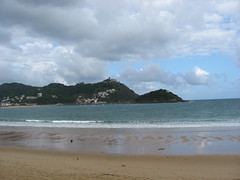 It was a quiet Sunday morning as we walked along the beach of San Sebastián, a town located around a cove on the northern coast of Spain. The sun was starting to clear the leftover haze from the previous day’s overcast, rainy weather in favor of a bright, clear blue sky a promising sight. Save for the few lone locals out for a morning stroll the promenade was mostly silent, except for when a large parade of bike riders competing in some sort of marathon came riding by. In many ways I was reminded of my hometown of Traverse City, Michigan: the bay you look north out of, the temperate climate, the 100-year old buildings, the clean streets and modern amenities, the river running through the commercial district, not too big, not too small, just the sort of place that feels like home. Except for the 600 foot tall cliffs bordering
It was a quiet Sunday morning as we walked along the beach of San Sebastián, a town located around a cove on the northern coast of Spain. The sun was starting to clear the leftover haze from the previous day’s overcast, rainy weather in favor of a bright, clear blue sky a promising sight. Save for the few lone locals out for a morning stroll the promenade was mostly silent, except for when a large parade of bike riders competing in some sort of marathon came riding by. In many ways I was reminded of my hometown of Traverse City, Michigan: the bay you look north out of, the temperate climate, the 100-year old buildings, the clean streets and modern amenities, the river running through the commercial district, not too big, not too small, just the sort of place that feels like home. Except for the 600 foot tall cliffs bordering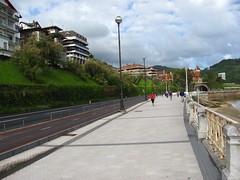 all sides of the cove. Those I wouldn’t find at home.
all sides of the cove. Those I wouldn’t find at home.
My inquisitor was a fellow expatriate on a student exchange program in Madrid by the name of Melissa. We met the prior night at the hostel as I was attempting to pick up the promised wireless signal. No luck. (Final Score: Spain five, me nothing.) We got to talking about where we were from and what we were doing while in Spain and I mentioned how my main interest for visiting San Sebastián was to go up Monte Igueldo where an old scenic railway was located at the top. She acknowledged that was also a location she wanted to go tomorrow morning before her bus left, although she was not previously aware there were any rides at the top.
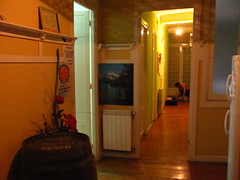 I had an invitation to join some of the group activities in the common lounge area that I had to postpone until I could get access to the internet and a printer such that I would be able to print my bus ticket from San Sebastián to Santander airport scheduled to depart at 11:25 the next day (my time on Monte Igueldo would accordingly be very limited). I also had a few other documents that needed printing for my arrival at British Customs, where I needed to be ready to begin my summer London philosophy program by that Sunday evening… and I was in desperate need of a meal. I did not have a chance to eat since breakfast before going to Tibidabo. Both requirements could be found down the street, in the form of a cheap Döner kebab (always a life-saver for any poor, young travelers in Europe out there) and an internet café,
I had an invitation to join some of the group activities in the common lounge area that I had to postpone until I could get access to the internet and a printer such that I would be able to print my bus ticket from San Sebastián to Santander airport scheduled to depart at 11:25 the next day (my time on Monte Igueldo would accordingly be very limited). I also had a few other documents that needed printing for my arrival at British Customs, where I needed to be ready to begin my summer London philosophy program by that Sunday evening… and I was in desperate need of a meal. I did not have a chance to eat since breakfast before going to Tibidabo. Both requirements could be found down the street, in the form of a cheap Döner kebab (always a life-saver for any poor, young travelers in Europe out there) and an internet café,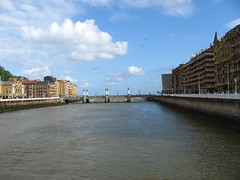 where the small group of regular patrons seemed extremely impressed that someone from as far away as I was would stumble into their humble abodes, and between printing off documents I tried holding a friendly conversation with a man even though he spoke maybe five words more of English than I did of Spanish.
where the small group of regular patrons seemed extremely impressed that someone from as far away as I was would stumble into their humble abodes, and between printing off documents I tried holding a friendly conversation with a man even though he spoke maybe five words more of English than I did of Spanish.
Upon my return I located Melissa and the rest of the group (mostly a mixture of British, American and Australian student travelers) and we agreed to go explore the San Sebastián nightlife. This involved hopping between a couple of bars and clubs, where I could not be convinced to order any drinks especially given the going rate unless I could somehow justify it as a ‘cultural experience’ as the sangria on the beach of Barcelona had been. I had no difficulties walking back to the hostel in a straight line after we were done. While talking with others though I discovered a startling piece of information: despite what the website said, Parque de Atracciones Monte Igueldo had not been open recently due to the colder-than-normal spring weather. A few mentioned that they went up to Monte Igueldo that afternoon (which was when I had planned on visiting in my original plan) and found only cold, rainy weather and a few of shuttered, silent rides. Uh oh, that doesn’t bode well for me. Eventually we parted was and our group made it back to the hostel by 1:30am. We would be waking up early tomorrow morning to be sure to be on the top of Monte Igueldo by its stated ten o’clock opening. I was still going to go, even if it would only be to look at the coaster and take a few pictures from the top.
I had no difficulties walking back to the hostel in a straight line after we were done. While talking with others though I discovered a startling piece of information: despite what the website said, Parque de Atracciones Monte Igueldo had not been open recently due to the colder-than-normal spring weather. A few mentioned that they went up to Monte Igueldo that afternoon (which was when I had planned on visiting in my original plan) and found only cold, rainy weather and a few of shuttered, silent rides. Uh oh, that doesn’t bode well for me. Eventually we parted was and our group made it back to the hostel by 1:30am. We would be waking up early tomorrow morning to be sure to be on the top of Monte Igueldo by its stated ten o’clock opening. I was still going to go, even if it would only be to look at the coaster and take a few pictures from the top.
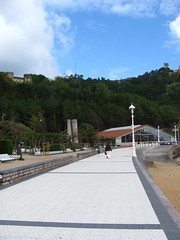 The hostel was still asleep when we left our keys at the desk and walked out the front door that morning. We shared stories and observations from our respective times in Europe, what going to school in Rome was like compared to Madrid or how we deal with language barriers. I was slightly sad that today would be my last day in a non-English speaking country after five months of inquiring “English?”, and using awkwardly mumbled local expressions mixed with pointing or charades when that option failed. I recalled stories such as the time I met our distant Italian relative in Venice, or when I had been locked out of the amusement park in Budapest for being ten seconds late and then talked my way into a free ride on the Hullámvasút with Hungarian security guards who spoke almost no English, and my experience of sleeping in a train station not once but twice. The way I view world travel is that if everything goes happily and the way you envisioned it, you’re not doing it right.
The hostel was still asleep when we left our keys at the desk and walked out the front door that morning. We shared stories and observations from our respective times in Europe, what going to school in Rome was like compared to Madrid or how we deal with language barriers. I was slightly sad that today would be my last day in a non-English speaking country after five months of inquiring “English?”, and using awkwardly mumbled local expressions mixed with pointing or charades when that option failed. I recalled stories such as the time I met our distant Italian relative in Venice, or when I had been locked out of the amusement park in Budapest for being ten seconds late and then talked my way into a free ride on the Hullámvasút with Hungarian security guards who spoke almost no English, and my experience of sleeping in a train station not once but twice. The way I view world travel is that if everything goes happily and the way you envisioned it, you’re not doing it right.
Before reaching the funicular station I was faced with that question: “why do I ride roller coasters”? It’s a question that I’ve never adequately answered.
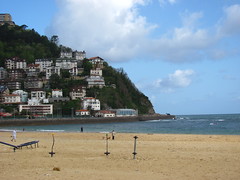 I instantly conceded that it’s most definitely not just for the thrill of adrenaline, if in fact it ever was. If that were the case I’d be on my way to Cedar Point to ride Top Thrill Dragster and Millennium Force again, not to some obscure historical Spanish park whose only coaster barely reaches 30 mph. Part of it was using it as a medium for experiencing different parts of the world, to observe different cultures in the context of their mechanical playgrounds; but if that were their only purpose I would have spent a day in Toledo rather than Parque Warner Madrid. There was also the poetic side I felt was too often ignored by other enthusiasts and was in many ways the impetus for this website. I wanted to sample as many different forms of coasters, to see which progressions work to tell the most satisfying narrative, which sequencing patterns
I instantly conceded that it’s most definitely not just for the thrill of adrenaline, if in fact it ever was. If that were the case I’d be on my way to Cedar Point to ride Top Thrill Dragster and Millennium Force again, not to some obscure historical Spanish park whose only coaster barely reaches 30 mph. Part of it was using it as a medium for experiencing different parts of the world, to observe different cultures in the context of their mechanical playgrounds; but if that were their only purpose I would have spent a day in Toledo rather than Parque Warner Madrid. There was also the poetic side I felt was too often ignored by other enthusiasts and was in many ways the impetus for this website. I wanted to sample as many different forms of coasters, to see which progressions work to tell the most satisfying narrative, which sequencing patterns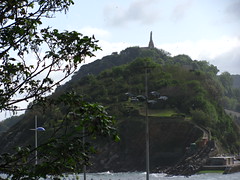 of elements flow like a jazz solo, and in general attempt to formalize the roller coaster experience so that it would no longer be viewed by the world as a device intended for the instant gratification of one’s amygdala, but as a modern art form that has the potential to stand shoulder-to-shoulder with music, drama and painting. But even this seemed untrue, too much of my superego talking, and it certainly didn’t explain ‘why roller coasters’ in the first place, why I was here now, in this moment, on my way to ride another.
of elements flow like a jazz solo, and in general attempt to formalize the roller coaster experience so that it would no longer be viewed by the world as a device intended for the instant gratification of one’s amygdala, but as a modern art form that has the potential to stand shoulder-to-shoulder with music, drama and painting. But even this seemed untrue, too much of my superego talking, and it certainly didn’t explain ‘why roller coasters’ in the first place, why I was here now, in this moment, on my way to ride another.
The object of my desired was the Montaña Suiza, a 1928-built scenic railway that runs along the top of one of those cliffs. About ten years earlier I had seen a photograph of a small scenic railway coaster car going around a bend on a stone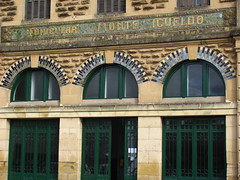 bridge overlooking a cartoonishly dramatic vista of the ocean and sheer rocky cliffs with seemingly nothing separating the two except for miles of open air. I still remember vividly the impression that photograph had on me, although immediately after seeing it I had to resign myself to the fact that I would never get to ride it as it was located in an obscure city on the coast of Spain.
bridge overlooking a cartoonishly dramatic vista of the ocean and sheer rocky cliffs with seemingly nothing separating the two except for miles of open air. I still remember vividly the impression that photograph had on me, although immediately after seeing it I had to resign myself to the fact that I would never get to ride it as it was located in an obscure city on the coast of Spain.
When Europe finally became a real possibility, I put at #1 for my list of roller coasters to ride on the continent the Montaña Suiza. Forget Expedition GeForce or Blue Fire or iSpeed or Dragon Khan. This ride was to be my destiny. I said without hesitation that, if need be, I would put down my €50 bill to get a ride this morning. I guess I really, really wanted the credit.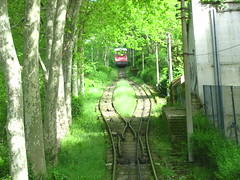
We arrived at the Monte Igueldo Funicular station a few minutes before ten, and found the place equally deserted. Eventually a few workers showed up and we were on the ride up the mountain just shortly after we were supposed to. The ride was admittedly a rather scary one, the vehicle guided up the steep grade by a basic railroad track configuration with a singular steel cable to keep us from rolling back down. That’s not even including the point at which the track reaches a split to let the opposing car pass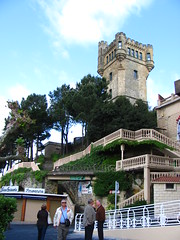 by using mechanical devices not apparently upgraded since it first started hauling visitors to the top in 1912.
by using mechanical devices not apparently upgraded since it first started hauling visitors to the top in 1912.
Disembarking at the top, I was pleased to see that not only did the weather seem fair but there were a number of other tourists already up there, although mostly older folks who were clearly not interested in the rides. It seemed like I might have a shot at the scenic railway being open today, as the website said it would at 10:00am. After a short exploration we found it, the station tucked in a tunnel underneath a building over a higher level of the hill, not even chained off. The train was on the track; I could go right up and touch it. The ticket booth was closed. No one was around to operate it.
“Okay, I only have like twenty minutes before I need to be back on the funicular to get to my bus. Can we find someone who might know if they can operate it?”
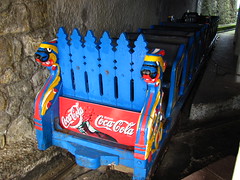 We searched but although the mountain was open, there was no one in attendance for any of the park’s rides. Montaña Suiza, closed. Casa del Terror, closed. The few children’s rides and slide, all closed. No one manning the bumper boats or small flume. No admissions booths or administrations office. As we walked along the back side we found a small hotel. Melissa was able to ask the receptionist if he knew if the roller coaster would be opening soon. He talked for a little bit, and then she thanked him.
We searched but although the mountain was open, there was no one in attendance for any of the park’s rides. Montaña Suiza, closed. Casa del Terror, closed. The few children’s rides and slide, all closed. No one manning the bumper boats or small flume. No admissions booths or administrations office. As we walked along the back side we found a small hotel. Melissa was able to ask the receptionist if he knew if the roller coaster would be opening soon. He talked for a little bit, and then she thanked him.
“What did he say?”
“He said because the weather was finally good today all the rides would be sure to open at 11:30.”
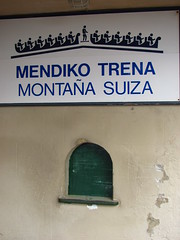 Oh no. That is exactly what I did not want to hear. My bus to catch my plane to London leaves town at 11:25. I needed them to be running when we got to the top at 10 o’clock, when the website said the park was supposed to open. If they were going to be closed all day, fine, I’d say ‘that’s that’, take a few more pictures, and learn to live with what fate had handed me. But this, the choice was now mine: do I leave now and catch my bus as according to plan, or do I wait just a little bit longer for the rides to open, knowing that I’ll have some steep consequences to accept later.
Oh no. That is exactly what I did not want to hear. My bus to catch my plane to London leaves town at 11:25. I needed them to be running when we got to the top at 10 o’clock, when the website said the park was supposed to open. If they were going to be closed all day, fine, I’d say ‘that’s that’, take a few more pictures, and learn to live with what fate had handed me. But this, the choice was now mine: do I leave now and catch my bus as according to plan, or do I wait just a little bit longer for the rides to open, knowing that I’ll have some steep consequences to accept later.
We walked back to the main observation deck overlooking the cove and the city of San Sebastián. As much as I wanted to stay there until 11:30, I knew I needed to be leaving to catch my bus in the next ten minutes. I should get my last photographs in now and resolve to the fact that I would not be one to ride the Montaña Suiza. Melissa offered a few condolences. “You tried and did your best. I guess it just wasn’t meant to work out.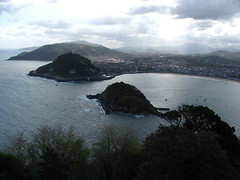 At least you were here and you got to see it.”
At least you were here and you got to see it.”
Somehow that didn’t mean the same thing for me. I knew it was stupid and irrational since the ride experience itself wasn’t going to be anything earth-shattering. But ever since I realized I would have a chance in my life to travel to Spain, knowing that I could be one of the few to be able to have “rode the Montaña Suiza” to my list of accomplishments, the only truly historical roller coaster in all of Mediterranean Europe, the only scenic railway built over stone and earth rather than a wooden structure, and the only roller coaster in the entire world built in a location this unique and breathtaking… that knowledge became part of my personal identity.
That’s why I ride roller coasters. They represent how I understand myself as a person. For as long as I remember when I first rode the Zach’s Zoomer with my parents in 1994, they have remained in some form the goal which motivated the rest of my projects. My day to day life has ever since had meaning because I was striving toward one day being the person who would design their own, the person who develops the original set of aesthetic criteria for coasters builders, the person who attempt to visit every major and historical park around the world, the person who, of those achievements, including riding this roller coaster, the one that left me slack-jawed a decade ago and figured I would never be able to ride, only to prove wrong ten years later. That’s who I am. If I were to deprive me of an opportunity to at least once coast along the steel rails of the Montaña Suiza, I would be leaving an essential piece of my identity behind in Spain.
“So, do you know what you’re going to do?” Melissa enquired as I continued to search over the coast and city for an answer. It was about time for us to be leaving; she herself had a bus to catch such that she could be back in Madrid for her classes that evening.
Too much had been lost already on this trip. The busses in Madrid wasted countless time and money. A smear on my camera’s lens tainted every picture I took in Terra Mítica and Valencia. I queued endlessly on my first day at PortAventura only because of horrible operations, and got my camera stolen the next. I had to pay €220 to get a replacement so I could continue my photographic record of Tibidabo and Monte Igueldo, only to discover that Tibidabo was not open the day I planned to go, requiring that I change my plan to visiting my two most-anticipated parks in Spain from a full evening’s visit to a few hurried hours in the morning such that I could still catch my bus to my plane to London on Sunday afternoon. I was not going to let my story end with me turning around and getting on a bus, mission unfilled, my only souvenir a quiet regret that would linger with me for days, weeks, months – who knows, maybe years.
“I think I’m going to stay,” I told her.
“Wow. I guess this must really mean a lot to you.”
“Yeah… it does.”
“Well, it was great having met you. Best of luck with your new plan!”
I thanked Melissa for her help and companionship and wished her well for the rest of her travels; we exchanged contact information before parting ways. Just before she turned to leave, I mused one final thought.
“You remember those ‘European adventure’ stories we were sharing on the way here? I’m pretty sure this will be the start of my biggest one yet.”
* * *
At first I walked around the park on top of Monte Igueldo, taking more pictures of the rides and views. The park is, in a word, small. Apart from the scenic railway there’s a walkthrough haunted house, a few small water or flume rides, and the rest appeared to be small portable children’s rides set up on concrete.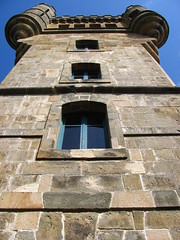 I found a bench on a terrace overlooking the scenic railway’s turn over the bumper boat pool, the same location where that original photo I had seen of this ride was taken. Watching as 11:30 drew nearer and the park showed signs of life, an employee getting all the bumper boats into the pond and ready for a day’s business, I observed that my last possible chance to get to my bus had come and gone. I continued to peacefully wait.
I found a bench on a terrace overlooking the scenic railway’s turn over the bumper boat pool, the same location where that original photo I had seen of this ride was taken. Watching as 11:30 drew nearer and the park showed signs of life, an employee getting all the bumper boats into the pond and ready for a day’s business, I observed that my last possible chance to get to my bus had come and gone. I continued to peacefully wait.
Eventually I decided to go up the stone outlook tower at the very top of Monte Igueldo, which had a small fee that was well worth it. The long stairway up was adorned with paintings and historical artifacts, and emerging in the open air at the top I could see for miles over the city and surrounding landscape. More picture taking commenced.
As I was up there, I noticed that the Montaña Suiza had started testing. I made my way back down to get my ride in. The price was two euro a ride; I handed over my last four in change, aware that this was likely to be the most expensive €4 I’d ever spend. I settled into the front seat, nothing more than a hard wooden bench with absolutely no restraining device of any kind. The only other person on this ride would be the brakeman. He dispatched the brake lever, and the cars creaked forward over the iron rails. I had my ride.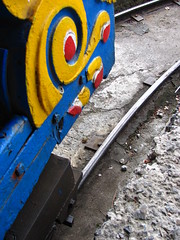
After turning out of the station the ride starts with a double dip through a narrow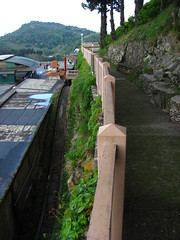 man-made ravine cut between the main structure on the mountain and a set of fairground stands, and abundance of wildflowers growing in the grass between the concrete track channels. After a second drop beneath a tunnel it rises into the long, slow turnaround above the bumper boat pool, strategically positioned such that as you make your way around the curve the entire world seems to open up before your eyes and you find yourself peering out over the infinite Atlantic Ocean with the rocky coastline hundreds of feet below.
man-made ravine cut between the main structure on the mountain and a set of fairground stands, and abundance of wildflowers growing in the grass between the concrete track channels. After a second drop beneath a tunnel it rises into the long, slow turnaround above the bumper boat pool, strategically positioned such that as you make your way around the curve the entire world seems to open up before your eyes and you find yourself peering out over the infinite Atlantic Ocean with the rocky coastline hundreds of feet below. Given how close you seem to come to the edge while the steel flanged wheels rolling over steel rails makes a primeval moan, the experience
Given how close you seem to come to the edge while the steel flanged wheels rolling over steel rails makes a primeval moan, the experience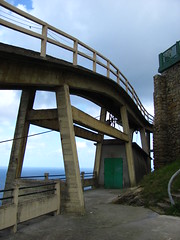 is more than a little harrowing despite being taken at barely five miles per hour. From here the train latches onto a cable lift, the only one on a scenic railway I’ve been on that still has the anti-rollback clack-clack-clack. Making a small turn at the top with the ocean still in view,
is more than a little harrowing despite being taken at barely five miles per hour. From here the train latches onto a cable lift, the only one on a scenic railway I’ve been on that still has the anti-rollback clack-clack-clack. Making a small turn at the top with the ocean still in view, the layout saves its climatic final drop as the biggest and most impressive, diving deeper than expected into an underground tunnel, the trembling from the primitive tracking technology as it reaches 30 miles per hour in the dark and without anything keeping you secured in your seat is momentarily disconcerting. Alas it is over all too soon, after coasting back up above the earth’s crust the brakeman slows down our two-car coach to let it rumble around the final turn and back through the tunnel to the station platform.
the layout saves its climatic final drop as the biggest and most impressive, diving deeper than expected into an underground tunnel, the trembling from the primitive tracking technology as it reaches 30 miles per hour in the dark and without anything keeping you secured in your seat is momentarily disconcerting. Alas it is over all too soon, after coasting back up above the earth’s crust the brakeman slows down our two-car coach to let it rumble around the final turn and back through the tunnel to the station platform.
He didn’t even stop in the station, so I put away my camera and enjoyed my second ride for itself, taking in every view, bump, squeal and smell that I could. Was the ride everything that I hoped? Well, given how much it took for me to get only two rides it’s perhaps a little hard for me to judge. It’s one of those coasters that you can’t use any traditional criteria; it’s too hallowed an artifact, too far outside the bounds of ordinary space and time in its own special pocket of the universe, such that anything other than what it is simply wouldn’t be the Montaña Suiza. Therefore I can’t really say things like “it might have been over too quickly” or “it spent too little time along the ocean”, or “it needed more after the final drop into the tunnel,”… tempting as they may be.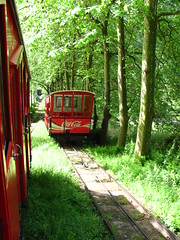
As I climbed out of the train, hoisting my backpack over my shoulders, I thanked the brakeman and the ticket attendant and made my way back to the funicular. It was approaching noon as the funicular departed back down along the mountain. I was in a small Spanish city with few mass transportation options where even fewer people spoke English, and needed to cover a distance of about 600 miles before the next morning with no transportation, no planned route, no map, no phone or internet access, little spare cash, and no idea what I was going to do next.
My adventure had officially commenced.






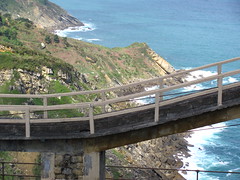






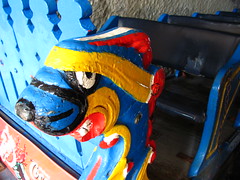
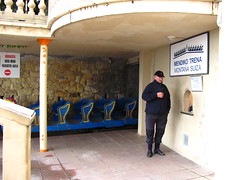

I was here purely by chance in the mid 90s. Vacationing from the US and just milling around town with some friends from France on a small road trip from Biarritz. Personally I hate roller coasters (too scared) but thought this one looked ridiculously benign, despite the crowds of riders getting off with pale complexions and frightened thousand yard stares. But despite being fooled by the truly frightening experience (not as bad as being tricked into riding the the coaster at Rockaway Playland which was one week short of being condemned) it was a great decision and a good memory. It looks like they upgraded the cars, the ones I remember were barely just park benches bolted to a wood platform on wheels, no decorations at all and certainly not painted blue. And it may be just my memory playing tricks but I dont remember a tunnel on the final hill, I distinctly recall just a big open air parabola.
I would just like to thank you for sharing these amazing experiences, your journey is an amazing and compelling read and being unable to make the trips for myself, I am deeply grateful for all the hard work that you put into your posts. Thank you.